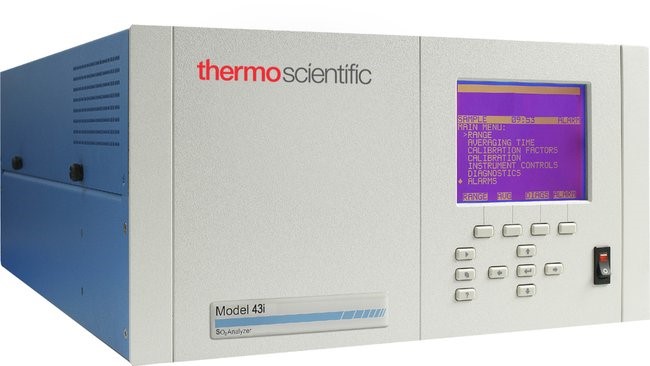Instrument Support Level 3
Thermo Scientific. 43i
Not Applicable
Calendar

TECO 43i SO2 Monitor
The Thermo Scientific Model 43i TLE2 Analyser measure SO2 in ambient air up to 100ppm This is the first gas analyser to utilize pulsed fluorescence technology to measure SO2
Reflective bandpass filters are less subject to photochemical degradation and more selective in wavelength isolation, resulting in both increased detection specificity and long term stability.
The Model 43i operates on the principle that SO2 molecules absorb ultraviolet (UV) light and become excited at one wavelength, then decay to a lower energy state emitting UV light at a different wavelength.
Specifically,
SO2 + hν1→SO2 *→ SO2 + hν2
The sample is drawn into the Model 43i through the SAMPLE bulkhead. The sample flows through a hydrocarbon “kicker,” which removes hydrocarbons from the sample by forcing the hydrocarbon molecules to permeate through the tube wall. The SO2 molecules pass
through the hydrocarbon “kicker” unaffected.
The sample then flows into the fluorescence chamber, where pulsating UV light excites the SO2 molecules. The condensing lens focuses the pulsating UV light into the mirror assembly. The mirror assembly contains four
selective mirrors that reflect only the wavelengths which excite SO2 molecules.
As the excited SO2 molecules decay to lower energy states they emit UV light that is proportional to the SO2 concentration. The bandpass filter allows only the wavelengths emitted by the excited SO2 molecules to reach the photomultiplier tube (PMT). The PMT detects the UV light emission from the decaying SO2 molecules. The photodetector, located at the back of the fluorescence chamber, continuously monitors the pulsating UV light
source and is connected to a circuit that compensates for fluctuations in the UV light.
As the sample leaves the optical chamber, it passes through a flow sensor, a capillary, and the “shell” side of the hydrocarbon kicker. The sample then flows to the pump and is exhausted out the EXHAUST bulkhead of the
analyzer.
Contact Grant Forster for details.
The last 24 hours of data can be viewed here
Higher frequency data can be obtained through a request to Grant Forster.
